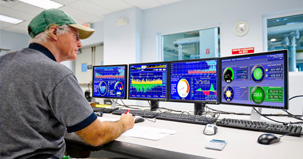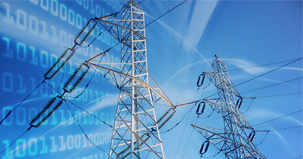- Home
- Smart Data
Smart Data
Actionable intelligence on energy and water use:
- Helps users identify inefficencies, and waste
- Provides real-time feedback on conservation
Right data for the right audience:
- Facility managers identify when and where energy is wasted
- CFO's can track and verify financial savings from initiatives
- Company knows its carbon and water footprint
Related Products
 Information any time, anywhere
Information any time, anywhere - Smart User
Smart User
Smart users leverage real-time data and reduce energy and water use by:
- Continuously identifying opportunities
- Acting on opportunities
- Tracking and verifying savings
- Sustaining savings
Related Products
 Monitor, Manage, Maintain
Monitor, Manage, Maintain - Smart Community
Smart Community
A smart community is one where all stakeholders are engaged in energy and water conservation. A smart community can be achieved by:
- Showing people precisely how much they are using
- Providing real-time feedback on conservation actions
- Effectively communicating efficiency results
Related Products
 Communicate and Conserve
Communicate and Conserve - Smart Grid
Smart Grid
Smart grid, as we define it, is a "green grid", with efficient resource use and the key to a low-carbon future. We help our customers prepare for the smart grid by:
- Engaging users with smart data
- Enabling smart users to increase resource efficiency
- Educating & empowering smart communities
Related Products
 Smart grid and a smarter future
Smart grid and a smarter future - Smart Buildings
Smart Buildings
Smart buildings maximize resource (energy, water, capital) efficiency. These buildings are optimized using energy and water management process with high data visibility which lead to reduced energy and water spending.
- Higher operating income and higher asset values for owners
- Increased productivity for occupants
- Lower carbon footprint for the community
 Resource efficient buildings
Resource efficient buildings
Recent Posts
Technology for Science's Sake
Have you ever wanted to walk across the beams of a skyscraper, look through the Hubble Telescope, or take your turn at a lab bench as a real scientist exploring human diseases? All of these opportunities can be yours for the price of an admission ticket to the Liberty Science Center (LSC) in Jersey City. When you enter the glass doors of the newly renovated, cutting-edge museum, you’re sure to be wowed by the science coming to life before your eyes.
But when Dennis M. Hercel, LSC’s director of facilities, walks through those doors, he looks right past the exhibits towards what’s going on behind the scenes.
When the 295,000-square-foot museum reopened in 2007 after a complete renovation, the facility launched a host of energy-savings initiatives, including solar arrays, updated lighting equipment, and improvements to the building’s HVAC systems, with the hopes of saving energy usage and costs.
However, LSC executives wondered, were those green initiatives worth the investment? How could they be sure they were saving energy and reducing LSC’s energy bills?
To find the answer, LSC contracted with Noveda Technologies, an award-winning global leader in real-time, Web-based energy system monitoring, to ensure return on investment. In April 2008, LSC installed the Noveda EnergyFlow Monitor to track the facility’s energy use and SunFlow Monitor to assess the performance of LSC’s solar photovoltaic system.
After the first night in use, EnergyFlow Monitor data showed that the facility was consuming three times more energy than originally estimated. The facility operations staff at LSC discovered that, between the hours of 10pm and 6am, the building’s air-handling units were running in “occupied” mode, bringing hot, humid air back into the building and wasting energy. By readjusting the night settings, daily electrical consumption was reduced by approximately 11 percent.
After teaming up with Noveda Technologies in an effort to cut facility costs by monitoring energy usage, Hercel and his colleagues say they are seeing green in more ways than one. In the first year of monitoring its energy systems with Noveda’s systems, LSC saved more than $700,000 and reduced its carbon emissions by 40 percent.
Anomaly or Real-World Case Study?
The Liberty Science Center is only one of more than 4.8 million commercial buildings in the United States. Add to that another 350,000 industrial facilities and, according to government reports, the combined annual energy cost for these buildings is more than $202 billion. But part of this equation is unfortunate: More than 30 percent of these buildings operate inefficiently, unnecessarily wasting energy and money.
Clearly, the environmental impact of such inefficiency and waste is exponential. If these are the statistics in the U.S. alone, one can only imagine the crushing reality of a worldwide study. However, while many businesses fail to act on their desire to ensure sustainability, it is possible to save energy and utility costs—one company at a time.
In fact, by installing an energy monitoring system in the facility, a company can be sure the building’s systems are working at optimum levels. And if anything goes wrong, the appropriate people will be notified of the problem and able to rectify it immediately, which means immediate savings to the bottom line.
At Liberty Science Center the savings have been extraordinary. After employing the Noveda energy-monitoring systems, the museum reduced electricity consumption in 2008 to 2009 by 4,210,070 KWh for a savings of $665,193, and reduced its natural gas consumption by $50,000.
Having access to the Noveda real-time data enabled LSC staff to track energy use, drive new energy-savings initiatives, and monitor the impact of simple, straightforward initiatives in real time, including: turning off booster pumps for hot water at night, adjusting lighting hours, cycling major equipment to maximize efficiency and comfort, and upgrading lighting fixtures.
And Liberty Science Center isn’t an anomaly, maintains Noveda CEO Govi Rao. In fact, it’s just one example of a smart, forward-thinking organization that is not only implementing sustainable energy strategies, but is also going one step further. By monitoring its systems, LSC is able to optimize energy usage and reduce utility bills.
Noveda’s client base includes renewable systems users, utilities, commercial, retail, industrial, government, and educational institutions. “Every building that has a meter is our potential customer,” Rao explains. “Noveda offers real-time monitoring for both conventional (natural gas and electric), water, and renewable energy systems. Our products and services enable customers to lower energy costs, reduce carbon footprint and enhance occupant comfort in their buildings.”
By utilizing Noveda’s tools—Web-based technology that is compatible with all Building Automation Systems, Energy Management Systems, and Utility Meters, and allows the customer access to a large database of real-time energy data—Hercel has blogged, “We’re able to see detailed conditions in real time. That allows us to monitor how much energy an elevator ride costs, how much energy the solar panels produce on a partly cloudy day, and even how much energy we save by turning off lights in little-used staff areas. We’ve used the tool to closely examine everything in the institution that pulls power, leaving no stone unturned. Nothing is too small to study, understand, adjust, and create savings.”
In addition to the tremendous savings reflected in the museum’s utility bills, LSC has qualified for rebate programs that have made it affordable to purchase new lighting elements and other products. The facility is also embarking on a major lighting upgrade to 1,200 fixtures; the retrofit will be paid for mostly by a rebate program. The remaining 20 percent will be financed interest-free over two years. LSC’s facility manager expects this project will reduce LSC’s energy consumption by another 600,000 KWh annually, saving the museum $93,000.
As a result of getting the scoop on exactly how the museum’s systems were working—or in some cases, not working—the museum reduced its energy usage by more than 40 percent in under a year with minimal maintenance costs. The energy savings also resulted in a 40 percent reduction in carbon dioxide emissions. Remarkably, the payback on the investment in Noveda’s technology came in less than three months.
“It turns out that saving energy is a lot like losing weight: Facilities often seek a quick fix to lower energy bills by slashing energy usage, but they can’t sustain it. A year later, they find that energy consumption has crept back up again,” says LSC’s Hercel. “The only way to lose weight and keep it off is to pay close attention to how many calories you consume versus how many you use. The only way to permanently reduce energy use is to know in detail how much energy you are using and how it is being used.”
Originally published in NJ & Company



